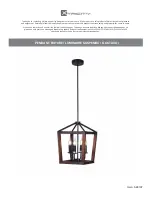
Chapter 4 — The QuadStat
43
need to consider the distance between the auxiliary and working
electrodes.
NOTE 1: The overload light may come on when a QuadStat channel is
being used for a second, third, or forth working electrode, and the
corresponding reference and auxiliary electrode connectors are not
being used, see
Using a Common Reference and Auxiliary, page 49
This does NOT indicate faulty operation.
NOTE 2: A potential overload is quite different from a current overload
condition. A current overload is caused when the current signal
exceeds the full scale limits of the sensitivity setting of the current
channel. This is, in turn, due to a low resistance between the electrodes.
In some circumstances a current overload can also cause the QuadStat
overload indicators to light.
The Back Panel
The back panel of the QuadStat is shown in
E Out, I Out and E In Connectors
The QuadStat is supplied with a 20 pin screw terminal adaptor,
, which plugs into the 20 pin socket on the back panel. The pin
positions are labelled I Out, E Out, E In, and COM, for each QuadStat
channel (Channels 1 – 4).
The COM (common) pins are provided for connection to signal ground
(black wires of the supplied coaxial cables,
). You can use
any COM pin for the ground connection of any I Out, E Out, or E In
signal.
I
2
C Connectors
The QuadStat back panel,
, has two DB-9 pin ‘I
2
C bus’
connectors labelled Input and Output. The Input connector provides
power to the QuadStat and carries the various control signals (for gain
range and filter selection) to and from the
e-corder
connection. A cable
is provided with the QuadStat for this purpose. The pin assignments are
shown in
Summary of Contents for e-corder
Page 62: ...58 eDAQ Potentiostats ...
Page 88: ...84 eDAQ Potentiostats ...
Page 94: ...90 eDAQ Potentiostats ...
Page 102: ...98 eDAQ Potentiostats ...
















































